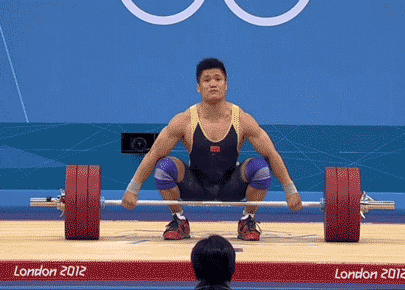Master Boring Fundamentals 02: Program Hopping and the Dangers of Knowledge Seeking
This is the second article in a series on Boring Fundamentals.
Hi, my name is James, and I’m addicted to program hopping.
Program hopping: jumping from one exercise regimen to another; displaying an inability to commit to a plan for its entire duration
I devour books and blog posts, chasing the perfect method, the perfect system. I try a new thing for a week or two–excited to change my life–for good this time. Then I devour more books and blog posts.
It would take an old-school Olympic lifting coach, a state record, and 35 unwanted pounds of fat gain before I really learned what was going on.
This is my story of how I came to realize my addiction, and how I’m crawling my way out of it, one boring fundamental at a time.
The Heisig Misdirection
2007. Fresh out of high school. Horrible poofy hair. All I wanted to do was keep studying Japanese.
I drove to the bookstore (remember those?) and found the language section. Sandwiched between Japanese for Dummies and Japanese for Busy People was the book: Remembering the Kanji by James Heisig.
Learn 2,200 kanji in 6 months! It seemed like the ultimate hack. I had heard horror stories of Japanese majors who couldn’t even read a newspaper after 4 years of study.

*A poster with all the Kanji you can learn in RTK*
I did some research and found a small community dedicated to Heisig’s book. Someone had made a flashcard app, and there was a forum too, full of rabid converts.
Was this for real? I dove in anyway.
Here’s what led me astray for the next decade: Heisig’s method actually worked.
Two years later I passed the JLPT 1, the highest level proficiency test, just with self-study.
Success with Japanese led me to believe that there were systematic hacks for everything, if you just found the right system…
I attributed all of my success to the methods used while completely ignoring the hours of studying I had put in.
Weightlifting and Program Hopping

Looking for the next thing, I found Olympic Weightlifting. It was the perfect level of esoteric: plenty of technique to discuss for hours, rare enough that I could look impressive to the layman. I was obsessed. Or rather, I was obsessed with reading about it. I spent all day on the Pendlay forums. I sent my credit card info to sketchy sites to get translations of russian texts. I read all the arguments about Chinese Pulls and Triple Extension and Maxing Everyday.
In the gym I changed programs every few weeks, trying whatever system was cool online. I made some progress–new lifters can do almost anything and get stronger–but I plateaued quickly. Meanwhile my gym buddy kept improving. How!? I was the one who read all the forums and bought all the books! When he started he could barely squat! Maybe I should switch to the Bulgarian method…
There’s nothing wrong with experimenting. The issue wasn’t the programs themselves (well some of them were crap). The issue was that I was a program hopper.
What’s program hopping? Instead of staying with one plan all the way through to the end, you get distracted by another shiny thing and change course. It’s the fitness equivalent of buying high and selling low. Programs need to be run all the way through to see the results. By switching to something else halfway through, you’re putting in all the work but not sticking around long enough to realize the gains.
Program hopping applies to domains outside of fitness too. I spent years dabbling with life-hacks: Ultraman sleep, nootropics, speed reading. Same with nutrition: I tried IF, Paleo, Keto, TKD, carb backloading, PSMF. If it had a cool name and some dudes on a forum praising it I would switch to it. But I never got the results I was looking for.
I wanted that same magic I found with the Heisig method. I just had to find the one-true-way.
Coach Reams
If you could personify an immovable object, it’d be Michael Reams. He’s barely taller than me but I doubt Michael Phelps could get his giant wingspan around him. Some guy shoved Michael once and promptly found himself pinned to a wall, feet dangling.
I walked into Michael Ream’s backyard-turned-weightlifting gym and asked for coaching. He smiled, asked a few questions, and handed me a generic photocopied program.
I was…skeptical. The exercise choice was all over the place. I was pretty sure I could program the squats better. It didn’t even follow Prilepin’s chart! Was this guy for real??
“Ah”, I thought. “After a few weeks he will give me a real program”
I used that program for 3 years. I broke a state record in the snatch with it. I squatted 150kg weighing 62 with it.
All that pffafing about with different programs made me forget to actually put in the work.
The Dangers of Knowledge Seeking
Learning, being excited about new things, all great. Wonderful. I sincerely encourage it.
But not all information is tailored for your context. The overwhelming majority of information available is not for you. A beginner home cook doesn’t need to know the difference between a santoku knife and a chef knife. They need to practice chopping onions.
But we want to see patterns, we want that little hack, that easier solution.
“Human beings are pattern-seeking animals. It’s part of our DNA. That’s why conspiracy theories and gods are so popular: we always look for the wider, bigger explanations for things.” — Adrian McKinty, The Cold Cold Ground
Most of all, we don’t want to be bored. The information we need is boring. The advanced stuff is sexy. We want to shoot guns, not carry bullets:
“Carrying bullets doesn’t make for good stories or movie scenes. Shooting them does…They’re inseparable pairs. The amazing stuff doesn’t work without the boring stuff.” – Morgan Housel
So we latch on to details and make convoluted plans, thinking we’re getting ahead, being smart.
Actually, we’re wasting our time.
The best systems, the newest tricks, the latest research, whatever Tim Ferris is eating for breakfast this month, none of it matters without the fundamentals.
More dangers of knowledge seeking:
- Increased complexity means there are more failure modes
- Reading about the latest cutting-edge research makes you doubt your current plan.
- Paralysis analysis: you can’t pick which program is best so you do nothing
- Program hopping: you switch between plans haphazardly
If your fundamentals aren’t solid you’re wasting your time learning advanced tactics and strategy.
Coach Reams knew all of this.
Olympic lifting is a very technical sport. You can argue for years about tiny minutiae regarding technique.
If you asked Coach about technique he’d grab another lifter to demonstrate. Instead of explaining the technique he’d launch into a story about his best lifter:
“Guy was strong as hell but didn’t have much upstairs…I oughta give you all lobotomies. You’d be a lot easier to coach.”
Ask him about nutrition?
“Coach, I heard the insulin spike from potatoes was really high because of its glycemic index, is it okay to eat potatoes or should I eat sweet potatoes or should I only eat fruits for carbs?”
“Sure. Listen. I’m putting you on the see-food diet. You see food? Eat it.”
It’s not like he didn’t know these details; he was just guiding us away from distraction.
Consistent training made it easy to get consistent sleep, made it easy to eat right, made it easy to stretch and recover everyday…
The advanced stuff would come later…
The Fall
Michael decided he’d had enough of the city and moved to the middle of nowhere. Left without a gym, I fell off the bandwagon.
I let my fundamentals slip. I gained 10 pounds. I kept eating like I was training, but was barely training at all. Another 15 pounds and well past the next weight class up, I still pretended I was ‘bulking’.
I started coaching a few lifters, confident in my knowledge of the sport, but increasingly embarrassed to not be taking my own medicine. Without noticing, I packed on yet another 10 pounds.
That 35 pounds of extra weight helped me break exactly zero of my personal records.
Why wasn’t I progressing? It must be because I didn’t have the right program for me! I began program hopping again, reading more books, not sticking with anything, seeking the magic bullet.
A Shift
I was in the middle of making yet another spreadsheet for yet another perfect program when the disembodied voice of Coach Reams laughed in my ear:
“You don’t need another damn spreadsheet. You need to stick with something for more than a month.”
I had been ignoring the lesson Coach had been showing me for years.
I had seen the results compound when I studied Japanese everyday. I had seen how consistency in weightlifting led to consistency in sleep, in nutrition, in my life.
All I was missing was consistency with the boring fundamentals.
Your Brain on Consistency
Let’s talk about your brain. Myelin is a layer of fatty tissue that grows around certain neurons. This layer allows neurons to fire faster and in a more coordinated way, enabling skill reinforcement. The more myelinated a circuit of neurons gets, the easier it is to perform whatever skill those neurons correspond to.

How does your brain choose where to grow myelin? Wherever you use them! Repeated use encourages myelin to wrap around those neurons.
This makes sense on a practical level: the more you practice something the easier it gets to do it again. The big problem: your brain is perfectly happy reinforcing the ‘eat ice-cream’ pathway as it is to reinforce the ‘go for a jog’ pathway.
Build consistency in one part of your life and it becomes easier. Say yes to training 100 times and the 101st time takes zero effort. This is why you see trite sounding advice like ‘make your bed everyday’. There are bleed-over effects that make everything else better.
The Real Lesson: Back to the Boring Fundamentals
Why did I succeed at Japanese, at weightlifting? Mostly luck.
I was thrust unaware into environments that encouraged consistency with the basics.
On the surface the Heisig method looked like a hack.
What Heisig really did was put me in an environment where I could practice the fundamentals everyday. It got me having fun, it made me excited enough to study something everyday for 6 months. With that kind of consistency, all I had to do was keep spiraling up until I passed the JLPT.
My coach’s photocopied program wasn’t magical.
What my coach really did was guide me away from distractions, buying enough time until I started believing in the process. He had gathered a small team of motivated lifters, all pushing each other. With that kind of consistency, all I had to do was wait for the results to come.
Heisig and Coach Reams had taught me a lesson that I had completely mis-interpreted: it’s not about the system, it’s about the boring fundamentals.
It’s possible to do these sorts of things intentionally, without getting lucky like I did. I’m doing it now. But that’s for another article.
Up next in this series:
- How to Master the Boring Fundamentals
- The Problem With Goals - Finite Games and Fragility
- Work Capacity, Compounding Effects, and Comparative Advantages
Earlier in this series:
Further Reading:
- How to Be Great by Steph Smith
- All or Nothing Productivity by Charles Chu
- Dealing With Uncertainty in Training by Matt Perryman
- Stop Wasting Time on the Details by James Clear
- Inseparable Pairs by Morgan Housel
Huge thanks to Huan for prompting this post on Twitter